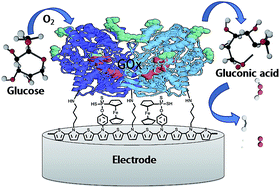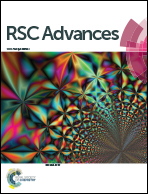A novel organic–inorganic hybrid conducting copolymer for mediated biosensor applications†
Abstract
A novel ferrocenyldithiophosphonate (TPFc) functionalized monomer and its conductive copolymer were synthesized, characterized and its potential use for biosensor applications was investigated. The structure of copolymer (P(TPFc-co-TPA)) which has free amino and ferrocene (Fc) groups was characterized by various techniques such as NMR and cyclic voltammetry. Afterwards, covalent immobilization of glucose oxidase (GOx) was carried out with glutaraldehyde using the amino groups on both the conducting copolymer and GOx. Fc on the backbone played a role as redox mediator during the electrochemical measurements. Therefore, the proposed copolymer P(TPFc-co-TPA) served as a functional platform for stable biomolecule immobilization and for obtaining the oxygen free mediated electrochemical responses. The current signals were recorded using glucose as substrate, at +0.45 V vs. Ag/AgCl in Na-acetate buffer (pH 4.5; 50 mM). Additionally, Kappm (20.23 mM), Imax (3.03 μA) and sensitivity (0.10 μA mM−1 cm−2) values were determined. Finally, the biosensor was successfully applied to glucose analysis in various beverages and the results were compared with data obtained from the spectrophotometric glucose detection kit as a reference method.


 Please wait while we load your content...
Please wait while we load your content...